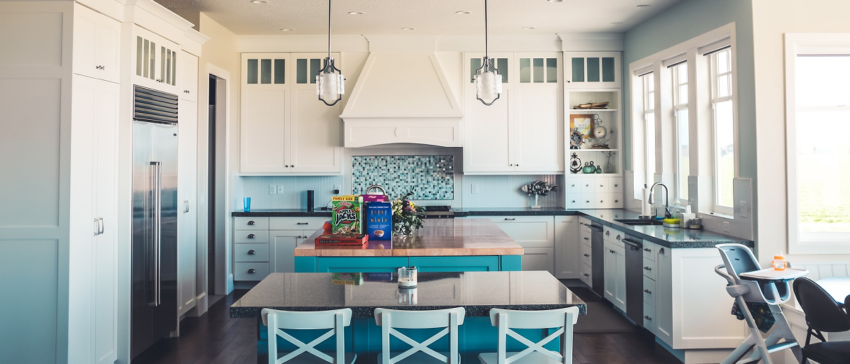Homeowners choose countertops based on many factors, including functionality, ease of cleaning and aesthetics. Oh, and price, to state the obvious. If you’ve been searching for the perfect countertop for your home, then you’ve likely found how difficult it can be to sift through your options and find a clear winner.
You can pretty much make a countertop out of any material you’d like, as many out-of-the-box thinkers have done in the past. While using pennies, cork and chalkboards might be a fun novelty choice, most homeowners opt for something a little more traditional and practical. Rather than steer you too far off-course, we want to focus on the tried and tested options available to homeowners.
Let’s de-muddy the waters and look at some of the most popular countertop options, including their benefits and drawbacks.
Granite
The good: The word you repeatedly see when reading descriptions of granite is “elegance,” and it’s hard to argue with that descriptor. Granite is one of the most visually appealing and durable of all countertop choices. It adds value to your home, in addition to the swag it offers your kitchen.
The not-so-good: Granite does have its downsides. It’s expensive, requires sealing to reduce stains and is vulnerable to cracks if overstressed or installed poorly. While these vulnerabilities aren’t deal breakers, they are worth considering when you think about investing in granite.
Marble
The good: The beauty of marble rivals that of granite. And, like granite, it also increases the value of your home. Every piece of marble is unique, so if you buy one, you’ll know that no one else will ever have that marble slab’s one-of-a-kind design. Another major bonus – marble is also waterproof and heat-resistant.
The flip-side: You might have guessed already that marble comes at a high price. It also requires regular resealing, and it is prone to scratching and staining, especially when it isn’t frequently resealed.
Quartz
The good: Engineered stone, as quartz is usually referred to, is manufactured, setting it apart from solid-stone options like granite and marble. It doesn’t require sealing, comes in many design and color options and is relatively easy to maintain.
The less-than-optimal: Quartz can be expensive, especially the higher-end options that are built well and will last for many years. It’s also less resistant to heat than granite.
Laminate
The good: Laminate has come a long way over the years. Today’s laminate can be very eye-catching, and it’s easy to clean. These plastic-bonded synthetics give buyers an almost limitless range of styles, patterns and colors, making them a versatile choice.
The sub-par: Laminate is more easily scratched than other countertop options. It is also not as heat-resistant. When laminate is damaged, it’s difficult to repair, though you also won’t be out as much money as you would with more expensive surfaces should you need a replacement.
Wood
The good: When done well, wood can be very attractive in a kitchen. There are many wood countertop options, from butcher-block to reclaimed wood. If properly maintained, they are easy to clean and durable.
The trouble areas: Wood must be cared for, so if you aren’t okay with regular oiling and sealing, be prepared to encounter stains, bacteria and scratches. Wood can also be expensive depending on the type you choose.
Countertop Lightning Round!
There are so many countertop options available, all with their own pros and cons. Here are a few other popular choices…
- Staron Solid Surfaces – It’s more affordable that granite and withstands more damage than laminate. Solid surface countertops are generally less heat-resistant than more expensive options, and some varieties can be easily scratched.
- Stainless Steel – It looks incredible, and it also offers bacteria resistance, durability and ease of cleaning. However, the best (and thickest) stainless steel can be pricey.
- Concrete – It offers a unique look and is a practical choice. It’s also resistant to scratching and heat. But it can be expensive, and it does require regular sealing. The concrete “look” isn’t everybody’s cup of tea.
- Ceramic Tiles – Tiles can be very pleasing to the eye, and they are often affordable. However, while tiles are easy to clean, the grout lines between tiles is less so. Tiles are also less durable than many of the other options we’ve discussed.
This countertop introduction covers most options that homeowners will pick from. You’ll have several choices, but the beautiful thing about installing new countertops in your home is that the choice is yours.

Ken Thieneman helps his clients build the homes they’ve always wanted where they can customize all those not-so-little choices that make a house unique to them. When you work with Ken, you’re partnering with an experienced, reputable builder who only works with trusted contractors.
If you’ve ruled out a custom home as an option, we encourage you to reconsider. So many clients come to us thinking that building a new, custom home is cost-prohibitive only to learn that, when done properly and on-budget, a new home is exactly what they were looking for.
Give us a call to learn more about your home-building options. We love to explore all the nuances that make a home unique for our clients, from open floor plans to the many countertop options you have available.


1 thought on “Which Type of Countertop is Best for Your Kitchen?”
Comments are closed.